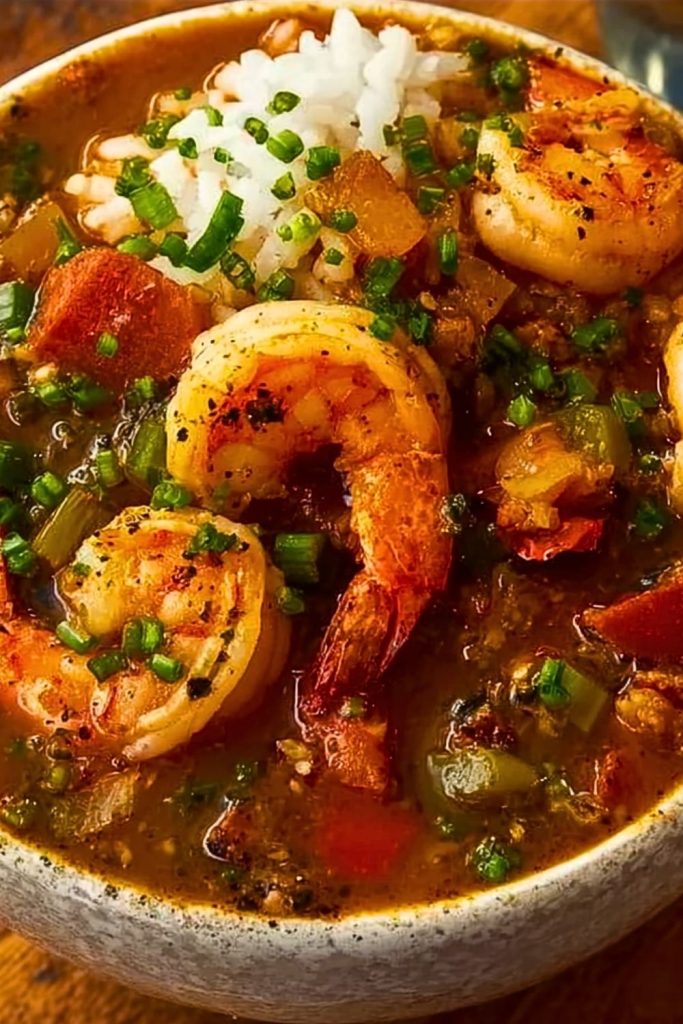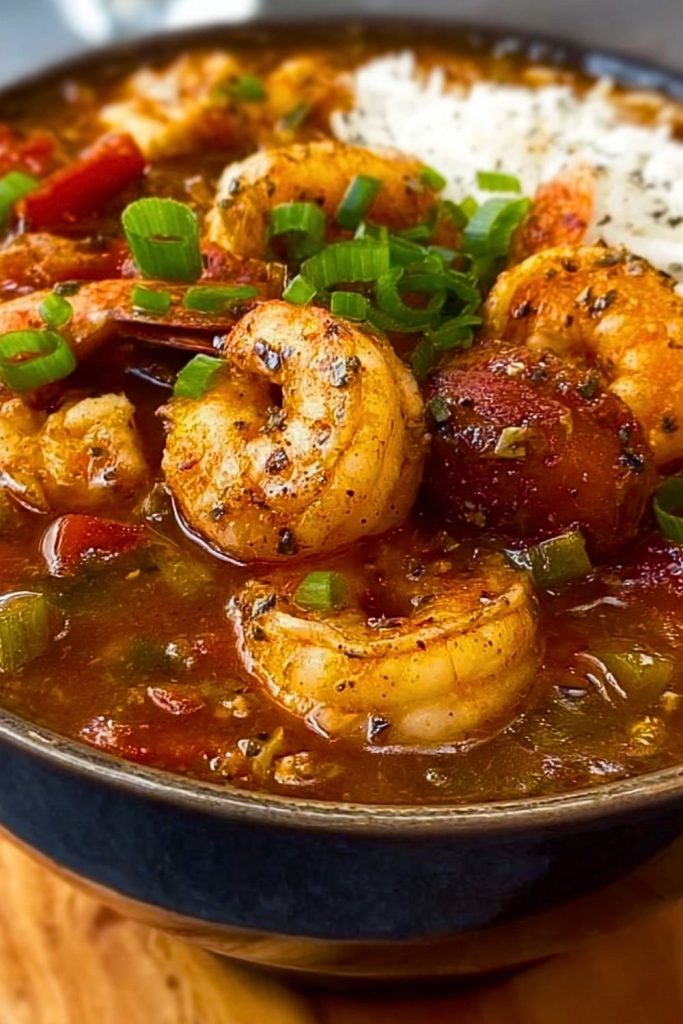Louisiana Seafood Gumbo is more than just a dish — it’s a cultural icon steeped in tradition, soul, and rich, bold flavors. A true melting pot of French, African, Spanish, and Native American influences, gumbo is the kind of meal that brings people together. Its deep, smoky roux base, slow-cooked with aromatic vegetables and seasoned to perfection, forms the foundation of this hearty stew. Add to that an indulgent medley of shrimp, crab, and sometimes crawfish or oysters, and you’ve got a comforting bowl of Southern warmth with every spoonful.

This gumbo is layered with complexity — from the slow-simmered stock to the pop of fresh green onions, and the unmistakable bite of Andouille sausage or chicken, depending on regional takes. Served traditionally over warm rice, Louisiana Seafood Gumbo is not only filling and satisfying but a deeply rooted expression of the South’s culinary soul.
Why You’ll Love This Louisiana Seafood Gumbo
Whether you’re craving a cozy winter dinner or want to impress at a weekend gathering, this gumbo delivers in every way. Its spicy, savory, smoky flavor profile paired with tender seafood and rich broth makes it unforgettable. It’s also surprisingly flexible — you can adjust the spice, the protein, or the consistency depending on your taste.
Plus, it’s a great make-ahead option. Like many stews and braises, the flavor only gets better overnight. Louisiana Seafood Gumbo isn’t just a meal, it’s an experience — one that feeds the belly and the soul.
Preparation Phase & Tools to Use (Essential Tools and Equipment, and the Importance of Each Tool)
Before diving into the flavorful depths of Louisiana Seafood Gumbo, gathering the right tools is crucial to ensure your cooking process is smooth and stress-free. Here’s what you’ll need and why it matters:
- Heavy-bottomed Dutch oven or stockpot: This is essential for building your roux and slow-simmering the gumbo evenly without burning. Its thick base helps maintain a steady temperature.
- Wooden spoon or flat-edged spatula: A must-have for stirring the roux constantly. Metal can scratch and plastic may melt, but a sturdy wooden spoon handles the heat and pressure best.
- Chef’s knife and cutting board: You’ll be chopping onions, bell peppers, celery, and garlic — the holy trinity of gumbo — plus sausage and other ingredients. A sharp knife makes prep faster and safer.
- Whisk: Helpful for smoothing out your roux and combining ingredients efficiently during the broth phase.
- Measuring cups and spoons: Precision matters for seasoning and liquid-to-ingredient ratios, especially if you’re new to gumbo-making.
- Fine mesh strainer (optional): If you’re making seafood stock from scratch, this will help remove shell bits and keep the broth smooth.
With the right equipment on hand, making gumbo becomes a labor of love rather than frustration.
Preparation Tips
- Prep everything before starting your roux. Once you begin cooking the flour and oil mixture, you can’t stop stirring — so having your “mise en place” ready is essential.
- Use room temperature seafood and sausage. This prevents the broth from dropping temperature too quickly when ingredients are added.
- Chop vegetables evenly. This ensures a consistent texture throughout the gumbo and prevents any ingredient from cooking unevenly.
- Don’t rush the roux. Let it develop slowly until it’s a deep chocolate brown — it’s the soul of your gumbo.
- Use homemade seafood stock if possible. It elevates the dish with more depth and richness than store-bought alternatives.
These steps may seem simple, but they’ll give your gumbo the authentic, well-developed flavor it deserves.
Ingredients for This Louisiana Seafood Gumbo
To create a pot of authentic Louisiana Seafood Gumbo, you’ll need a mix of fresh seafood, vegetables, stock, and seasonings that come together into a bold, comforting stew. Here’s everything required:
Seafood & Proteins
- 1 lb medium shrimp, peeled and deveined (reserve shells for stock)
- 1/2 lb lump crab meat (fresh or canned)
- 1/2 lb crawfish tails (optional)
- 1/2 lb Andouille sausage, sliced into rounds
- 1 cooked blue crab, cleaned and split (optional but traditional)
Vegetables
- 1 medium onion, finely chopped
- 1 green bell pepper, diced
- 2 celery stalks, diced
- 4 cloves garlic, minced
- 1 bunch green onions, chopped (for garnish)
- 1/4 cup fresh parsley, chopped
Roux & Liquid Base
- 1/2 cup all-purpose flour
- 1/2 cup vegetable oil or butter (or a mix)
- 5–6 cups seafood stock (preferably homemade)
- 1 (14 oz) can diced tomatoes (optional, for Creole-style gumbo)
Seasonings & Extras
- 2 bay leaves
- 1 tbsp Cajun or Creole seasoning
- 1 tsp smoked paprika
- 1/2 tsp dried thyme
- Salt and black pepper to taste
- A few dashes of hot sauce (like Tabasco), to taste
- Cooked white rice (for serving)
- Filé powder (optional, for thickening and added flavor)
Each ingredient plays a key role — from the smoky sausage to the sweet crab — creating the complex, deep flavor Louisiana gumbo is known for.

Step 1: Make the Roux
In a heavy-bottomed Dutch oven or large pot, heat the oil over medium heat. Gradually whisk in the flour, stirring constantly. Continue to stir for 20–30 minutes, or until the roux reaches a deep chocolate-brown color. Be patient — this step is crucial and can’t be rushed.
Step 2: Add the Holy Trinity
Once the roux is ready, immediately stir in the chopped onions, bell peppers, and celery. Sauté for about 5–7 minutes until the vegetables begin to soften. Add the minced garlic and cook for another minute, stirring to prevent burning.
Step 3: Add Sausage and Seasonings
Toss in the sliced Andouille sausage and cook for 3–5 minutes to brown slightly. Stir in the Cajun seasoning, smoked paprika, thyme, and bay leaves. Let the spices bloom in the roux and vegetable mixture.
Step 4: Deglaze and Build the Broth
Pour in the seafood stock slowly, whisking to combine and avoid lumps. If using, add the diced tomatoes. Bring the gumbo to a gentle boil, then reduce to a simmer. Let it cook uncovered for 45 minutes, stirring occasionally. This allows the flavors to deepen and meld together.
Step 5: Add Seafood
Add shrimp, crab meat, and crawfish tails (if using). Simmer for 5–7 minutes or until the shrimp are pink and cooked through. Be careful not to overcook the seafood.
Step 6: Final Touches
Taste and adjust salt, pepper, and hot sauce as needed. Stir in the chopped parsley. If desired, sprinkle in a little filé powder for extra thickness and earthy flavor.
Step 7: Serve
Ladle the gumbo into bowls over a scoop of hot white rice. Garnish with chopped green onions and a little more parsley. Serve hot, with extra hot sauce on the side for those who like it spicy.
Notes
- Roux Color Matters: The darker the roux, the deeper the flavor. A peanut butter-colored roux is good, but a chocolate-brown one is ideal for gumbo.
- Seafood Timing is Key: Add the seafood toward the end to avoid overcooking and becoming rubbery.
- Customize It: This gumbo is flexible — you can add okra, switch crab for scallops, or even toss in chicken for a mixed version.
Watch Out for These Mistakes While Cooking
- Burning the Roux: This is the #1 gumbo killer. Stir constantly and never leave the pot unattended. If it smells burnt, start over.
- Adding Seafood Too Early: Seafood cooks quickly. If it’s added too soon, it will become chewy and lose flavor.
- Skipping Homemade Stock: Using water or bland stock can flatten the flavor. If possible, make a seafood stock using shrimp shells and crab parts.
- Overloading the Pot: Gumbo is meant to be hearty, but overcrowding it with too many ingredients can make it muddy. Stick to a balanced mix.
- Underseasoning: Gumbo thrives on bold flavors. Taste often and adjust seasoning — especially salt and hot sauce — during cooking.
- Not Letting It Simmer Long Enough: That slow simmer time helps the flavors marry. Rushing it will result in a shallow-tasting gumbo.
- Serving Without Rice: While technically optional, gumbo without rice is missing a classic Southern pairing that balances the stew’s richness.
- Forgetting Garnish: Fresh parsley and green onions add brightness and color. They’re more than just decoration — don’t skip them!
What to Serve With Louisiana Seafood Gumbo?
A bowl of gumbo is satisfying on its own, but pairing it with the right sides can take your meal to the next level. Whether you’re hosting a dinner party or enjoying a cozy meal at home, here are some delicious ideas to complete the experience.
8 Recommendations
- White Rice
The classic gumbo companion — it absorbs the broth and gives each bite extra body. - Cornbread or Corn Muffins
Slightly sweet, soft, and perfect for sopping up extra gumbo from the bowl. - Potato Salad
Yes, it might sound odd, but in parts of Louisiana, gumbo is served with or even over cold potato salad. - French Bread or Garlic Bread
Crunchy on the outside and soft inside, ideal for dipping into the savory stew. - Okra Fries or Fried Okra
A nod to gumbo’s roots — crispy okra adds a great side crunch and texture contrast. - Collard Greens or Mustard Greens
Bitter greens sautéed with bacon or ham bring smoky depth and a healthy side. - Cajun Coleslaw
Something fresh and tangy with a bit of spice that complements the gumbo without overpowering it. - Sweet Tea or Abita Beer
For drinks, a refreshing Southern sweet tea or local Louisiana beer pairs wonderfully with the bold spices of the gumbo.
Storage Instructions
Louisiana Seafood Gumbo stores beautifully and often tastes even better the next day as the flavors continue to develop. Here’s how to keep it fresh:
- Refrigerator: Let the gumbo cool completely before transferring it to airtight containers. Store in the fridge for up to 3 days. Reheat gently on the stovetop over medium-low heat.
- Freezer: While the roux-based broth freezes well, delicate seafood like shrimp and crab may lose texture after thawing. If freezing, consider removing the seafood and adding it fresh when reheating. Freeze in portioned containers for up to 3 months.
- Reheating Tip: Thaw overnight in the fridge if frozen. Heat on the stove until hot all the way through. Add a splash of stock or water if it’s too thick.
Estimated Nutrition (Per Serving)
Note: Values are approximate and may vary depending on exact ingredients and portion sizes.
- Calories: 410
- Protein: 28g
- Fat: 22g
- Saturated Fat: 6g
- Unsaturated Fat: 13g
- Trans Fat: 0g
- Carbohydrates: 22g
- Fiber: 2g
- Sugar: 4g
- Cholesterol: 150mg
- Sodium: 940mg
- Serving Size: 1.5 cups with rice
- Diet: Pescatarian (if no sausage), Dairy-Free (if using oil)
Frequently Asked Questions
1. Can I make this gumbo ahead of time?
Yes! Gumbo actually tastes better the next day after the flavors have had time to meld. Just reheat it gently on the stove and add a splash of water or broth if needed.
2. What’s the difference between gumbo and jambalaya?
Gumbo is a stew served over rice, with a roux-based broth. Jambalaya is a one-pot rice dish where the rice is cooked directly with the meat and seasoning.
3. Can I use frozen seafood?
Absolutely. Just make sure it’s fully thawed and drained before adding it to the gumbo to avoid watering down the broth.
4. Is okra required in this gumbo?
No, this version focuses on a dark roux as the thickener. Okra is optional but traditional in some regional versions of gumbo.
5. Can I make this gumbo gluten-free?
Yes. Substitute the all-purpose flour in the roux with a gluten-free flour blend (like rice flour) and ensure your sausage is gluten-free.
6. How spicy is this recipe?
It has a moderate Cajun kick, but you can easily adjust the heat by using less (or more) hot sauce and seasoning.
7. What does filé powder do?
Filé (pronounced fee-lay) is ground sassafras leaves. It adds an earthy flavor and acts as a thickener when added at the end or at the table.
8. Can I make this without sausage?
Yes. Omit the Andouille sausage and increase the seafood or substitute with a plant-based sausage for a pescatarian or lighter version.
Conclusion
Louisiana Seafood Gumbo is a dish rich with history, flavor, and Southern charm. Whether you’re new to Cajun cooking or a seasoned home chef, this recipe brings the soul of Louisiana right to your kitchen. With its smoky roux, vibrant veggies, and tender seafood, it’s a deeply satisfying meal that never fails to impress. Serve it up over fluffy white rice with your favorite sides, and you’ve got a feast worthy of celebration — or just a comforting weeknight dinner.

Louisiana Seafood Gumbo
- Prep Time: 20 minutes
- Cook Time: 1 hour 20 minutes
- Total Time: 1 hour 40 minutes
- Yield: 6 servings
- Category: Dinner
- Method: Stovetop
- Cuisine: Cajun, Southern
Description
Ready to spice up your dinner plans? This *Louisiana Seafood Gumbo* is a bold, comforting, and flavor-packed Southern classic that’s perfect for any occasion. Made with a deep, smoky roux, a medley of shrimp, crab, and sausage, and slow-simmered in rich Cajun seasoning, this easy dinner recipe brings the taste of New Orleans straight to your kitchen. Whether you’re looking for cozy dinner ideas, a hearty weekend meal, or a show-stopping party dish, this gumbo delivers. It’s a top pick for anyone who loves easy recipes with big flavor — especially seafood lovers!
Ingredients
1 pound medium shrimp, peeled and deveined
1/2 pound lump crab meat
1/2 pound crawfish tails (optional)
1/2 pound Andouille sausage, sliced
1 cooked blue crab, cleaned and split (optional)
1 medium onion, finely chopped
1 green bell pepper, diced
2 celery stalks, diced
4 cloves garlic, minced
1 bunch green onions, chopped
1/4 cup fresh parsley, chopped
1/2 cup all-purpose flour
1/2 cup vegetable oil or butter
6 cups seafood stock
1 can (14 oz) diced tomatoes (optional)
2 bay leaves
1 tablespoon Cajun or Creole seasoning
1 teaspoon smoked paprika
1/2 teaspoon dried thyme
Salt and black pepper to taste
Hot sauce to taste
Cooked white rice, for serving
Filé powder (optional)
Instructions
1. In a large Dutch oven, heat oil over medium heat. Slowly whisk in the flour, stirring constantly for 20–30 minutes until the roux is dark brown like chocolate.
2. Add chopped onions, bell peppers, and celery. Sauté for 5–7 minutes until softened. Stir in garlic and cook for 1 more minute.
3. Add sliced sausage and cook for 3–5 minutes. Stir in Cajun seasoning, smoked paprika, thyme, and bay leaves.
4. Gradually pour in seafood stock while whisking to combine. Add tomatoes if using. Bring to a boil, then reduce to a simmer for 45 minutes.
5. Add shrimp, crab, and crawfish tails. Simmer for 5–7 minutes until shrimp are pink and just cooked through.
6. Taste and adjust seasoning with salt, pepper, and hot sauce. Stir in parsley and filé powder if desired.
7. Serve hot over rice. Garnish with green onions and extra parsley.
Notes
Always stir your roux — once it burns, you have to start over.
Let the gumbo simmer to let the flavors develop fully.
Use homemade seafood stock if possible for a deeper, richer taste.
Nutrition
- Serving Size: 1.5 cups with rice
- Calories: 410
- Sugar: 4g
- Sodium: 940mg
- Fat: 22g
- Saturated Fat: 6g
- Unsaturated Fat: 13g
- Trans Fat: 0g
- Carbohydrates: 22g
- Fiber: 2g
- Protein: 28g
- Cholesterol: 150mg
Keywords: Louisiana gumbo, seafood gumbo, Cajun dinner, shrimp and crab stew

